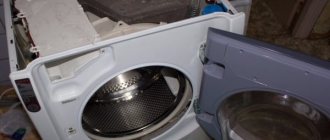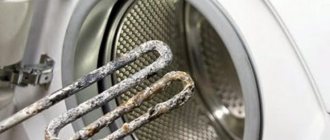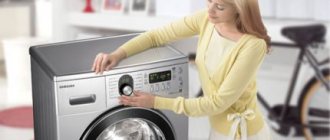Have you noticed that your washing machine has started to make a loud noise and jump during the spin cycle? Perhaps the reason is that the drum is unbalanced. If you have such a problem, you need to solve it, because excessive noise and vibration not only disturb you, but also lead to wear on the parts of the washing machine.
In earlier models, the imbalance leads to strong vibrations during the spin cycle. And modern models can stop if the system fails to restore balance.
Why does the drum become unbalanced?
The drum becomes unbalanced during spinning. The laundry bunches up into one lump, causing an imbalance and causing the machine to shake violently. Below are the main reasons why imbalance occurs:
- When washing bedding, smaller items could get caught in the duvet cover. The result was a large piece of underwear.
- There is too much or too little laundry in the drum.
- Washing at temperatures above 60 degrees is accompanied by additional water intake during rinsing. This may lead to a slight imbalance. Pay attention to this when choosing the water temperature.
- Mechanical problems can also be a culprit. Worn bearings or a rusty, bent shaft lead to increased vibration, and spinning may not occur at all.
Some washing machine models display an error code on the display, which indicates an imbalance.
Faulty shock absorbers in the washing machine
The most common cause is shock absorbers. They are precisely designed to dampen vibration in the washing machine, but over time they wear out and fail to cope with their task.
Signs of malfunction:
- high vibration during spinning;
- in the washing or rinsing mode, a measured tapping sound is heard;
- When the drum stops, a dull knock is heard.
You can check the shock absorbers without disassembling, just open the loading hatch and press the drum. It should sag a little and then smoothly return to its place. If the drum gives in easily and sways from side to side, then the shock absorbers are out of order.
Replacing shock absorbers
How to eliminate vibration in a stylish car if the shock absorbers are faulty. They are replaced only in pairs, as they evenly distribute the load. Replacing only one will not eliminate vibration. First you need to measure them, but to do this correctly, you will have to remove one. What dimensions are needed when ordering a new shock absorber:
- overall dimensions when folded;
- center distance between fasteners;
- the size of the fasteners themselves (width, length, diameter).
To replace them, place the car on either side, the tank will rest on the wall and the shock absorbers will be released, after which they can be easily changed. Pay special attention to tightening the mounting bolts and nuts so that they do not loosen during operation. To do this, tighten all fasteners, wait 5 minutes and check them again.
I recommend: How to work an angle grinder (“grinder”)
How to balance a drum with your own hands
Washing machine drum balancing is automatically built into modern models from Samsung, LG, Bosch, and Ardo. This additional feature is called "Imbalance Control". In this case, the system will not allow the washing machine to spin until the problem is resolved. To do this, the drum rotates in different directions, sometimes slowing down, sometimes accelerating.
If you set the spin to maximum speed, but the imbalance is not corrected, then the machine will significantly reduce the spin speed so as not to harm its parts. Or the spin cycle will be stopped altogether. In any case, you will get almost wet laundry out of the drum.
How to do balancing yourself? Proceed sequentially:
- Unplug the washing machine.
- If the car stops full of water, you need to drain it.
- At the bottom of the front of the hull you will see a small hatch.
- Using a flathead screwdriver, release the latches and open the hatch door.
- Place the container and unscrew the filter from the housing.
- After draining the water, open the hatch door.
- Distribute the laundry evenly by hand or remove half of the items from the bin.
- Then resume washing.
Top-loading washers make it easier to center laundry because you don't have to drain the water to open the door. If, after distributing the items, the washer shakes again during the spin cycle, check the balancing stones. They are located behind the front and rear panels of the SMA and are attached to the drum. Sometimes their fastenings become loose, leading to imbalance.
The washing machine jumps during washing - reasons
Vibration of the machine during the spin cycle can be caused by various reasons, the most common of which are discussed below.
Incorrect installation of the washing machine
Improper installation on the floor is one of the common reasons why the washing machine makes a lot of noise and jumps during the spin cycle.
Ideally, the washing machine should stand without tilting or distortion, all legs should touch the surface. The floor should be level and smooth, but not slippery. If these conditions are violated, the automatic machine at high speeds begins to swing towards the slope, shake and make a lot of noise.
https://youtube.com/watch?v=BlODPmJoijM
Uneven distribution of laundry in the drum
The washing machine jumps during the spin cycle when the laundry is unevenly distributed over the drum area. It can clump together, for example, when small items get caught in a pillowcase. In this case, the entire weight of the wet laundry falls on a small area of the drum, as a result the machine swings strongly in the direction of movement of the resulting lump.
Also, the operation of the equipment may be disrupted due to overload if the weight of the contents exceeds what is allowed according to the instructions. Then the drum cannot rotate at the required speed, and the entire mass of things exerts prolonged pressure on the lower section. When underloaded, the laundry is thrown sharply over the entire available area, which also rocks the washing device.
Transport bolts
Shipping bolts are a fastening mechanism that protects the tank and shock absorber from swinging, wall impacts, and damage during transit. The device works even if the fasteners are not removed, but the washing machine shakes and rattles, and its parts wear out faster.
Spring or shock absorber failure
Shock absorbers, like springs, are designed to dampen tank vibrations that occur when the drum unwinds. Over time, especially with frequent overloads of the machine, these parts wear out.
The shock absorbers are located at the bottom, right under the drum; they are clearly visible if you turn the washer over. Usually there are 2 or 4 of them, depending on the model. The springs are located in front of the tank and behind it. When they are worn out, broken, or the fasteners come off, the machine begins to sway and knock as the tank sags.
Foreign objects
When you spin shirts and dresses in the washing machine, small parts often come off (buttons, decorative bows, patches, bra underwires, pieces of wool, etc.). The torn pieces get stuck between the tank and the drum, causing the equipment to shake.
Loosening the belt
In a number of machines, a special belt goes from the motor to the drum. When power is applied, the motor rotates and with the help of this connecting drive begins to spin the drum. Sometimes the belt wears out, falls off, or its tension becomes weaker, which makes the movements uneven and rocks the structure.
Bearing failure
Bearings are the metal or plastic parts that connect the pulley to the drum. Usually there are two of them: internal and external. They differ in size, distance from the drum and working load.
Under the influence of liquid and a humid microclimate inside the washing machine, the bearings begin to oxidize, and then rust and wear out, and can completely collapse. At the same time, the drum swings freely to the sides when moving and rotates unevenly, turning with difficulty in certain areas. In the most severe cases, it completely jams and water begins to flow from under the machine.
On average, bearings remain operational for 7 years. It is not recommended to use equipment with such damage, as fragments of the part can completely break the washing machine.
Counterweight failure
Counterweights are two heavy concrete or plastic structures that are located in front of the drum and behind it, next to the springs. They are also used to dampen vibrations during movement and ensure the stability of the entire structure. As a result of wear, they can crumble into several parts, or the mounting bolts may fly off.
Problems with the electric motor
Most often, the problem that causes the machine to shake does not lie in the engine itself, but in loose mounts of the electric motor. It is located on the back cover of household appliances. Detection of a fault in the electronic circuitry of a device is only possible for technicians with special equipment.
How to avoid imbalance
Make sure that you load the drum according to the norm for your washing machine. If the washing machine is designed for three kilograms of laundry, this does not mean that you need to fill the drum to capacity. It should be 2/3 full. And:
- Do not fill the car with items that are too bulky. When wet they become heavy and can cause overload and imbalance.
- Try to load large and small items together for proper SMA balance.
If you are just going to buy a washing machine, choose the load capacity in accordance with the number of everyday items to wash. If, when choosing a drum volume of 7-8 kg, you cannot collect enough for a daily load, washing once a week will not always be convenient.
Why does the drum shake?
The bearings are damaged.
The shock absorbers are broken.
The crosspiece is cracked.
A foreign object is stuck in the tank.
These reasons cause increased play in the machine.
To correctly diagnose the problem, pay attention to the characteristics of the looseness, the size of the gap
How to check play
Spin the empty cylinder by hand. If it creaks when moving and touches the tank, it means the bearing has become loose. A broken bearing also causes leakage during the washing process.
Pull the drum towards you and release it. If it wobbles a lot, sways, falls out, sinks, or spontaneously separates from the cuff, the shock absorbers have failed.
When the drum moves, does the body shake, twist sharply, does it seem like the machine has “gone crazy”? Most likely the crosspiece is cracked.
The movements are smooth and silent, but is there something rattling and rattling on the walls? It looks like a small object is stuck in the tank. If you know how to use tools, you can fix these troubles at home.











